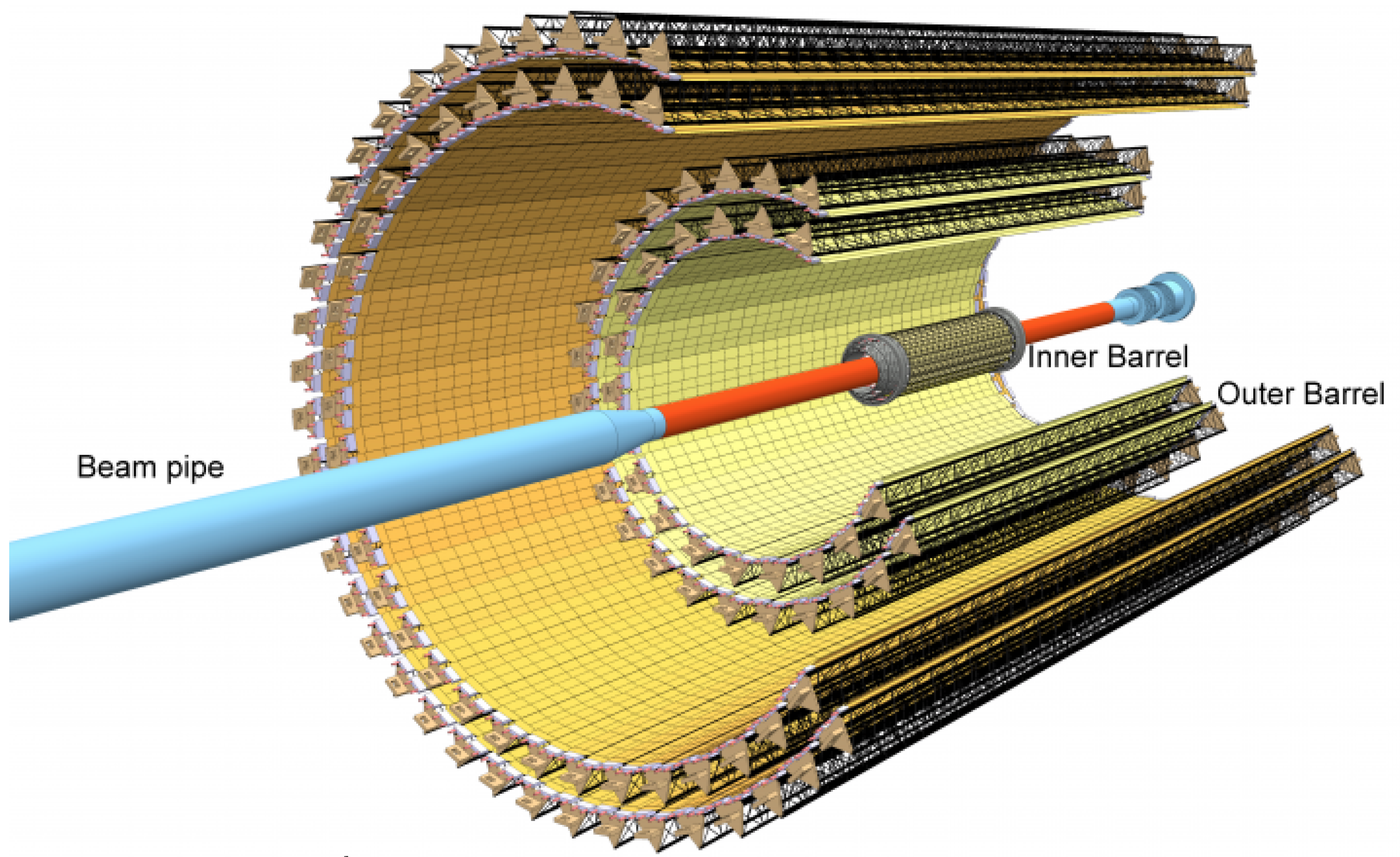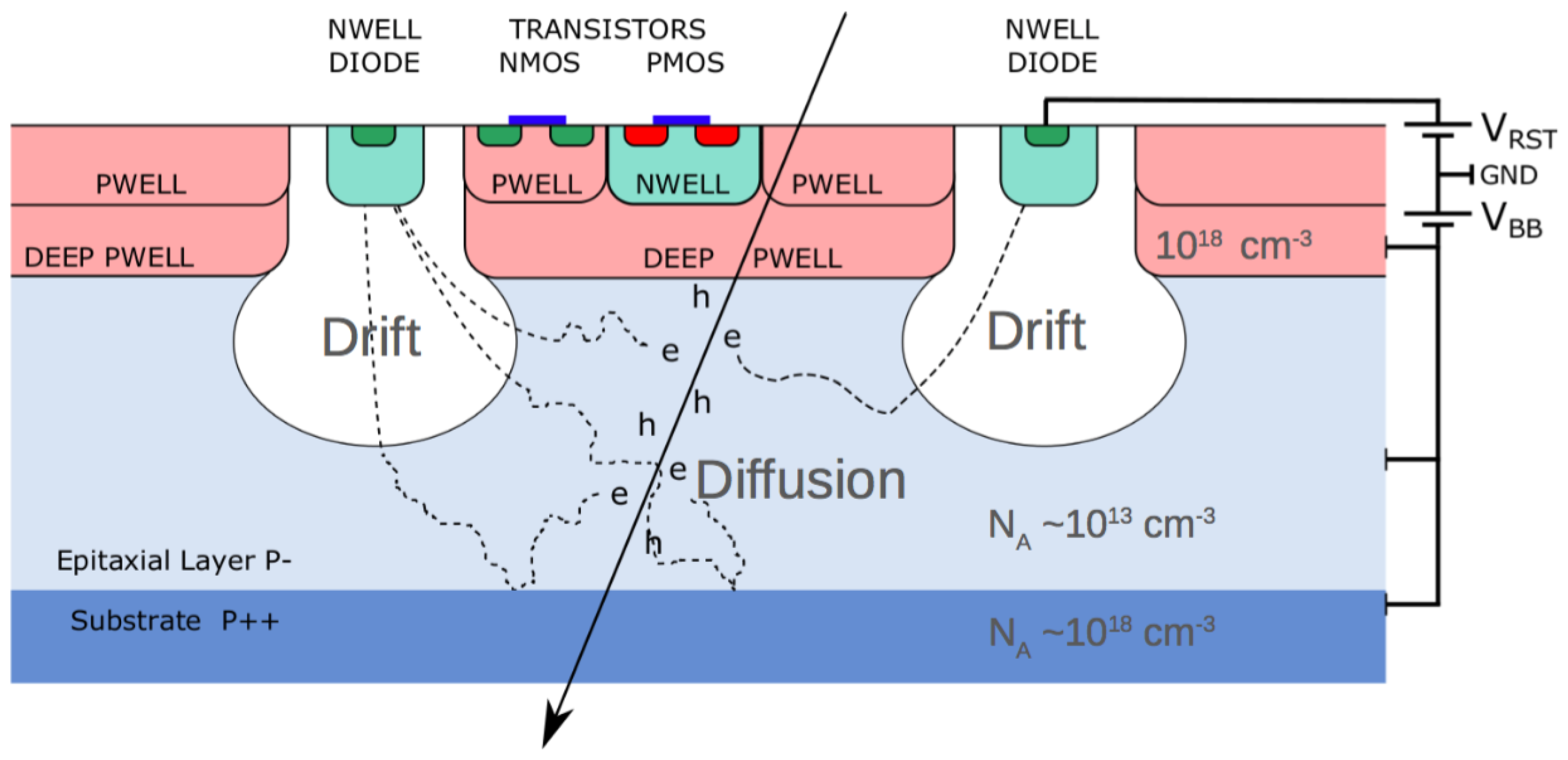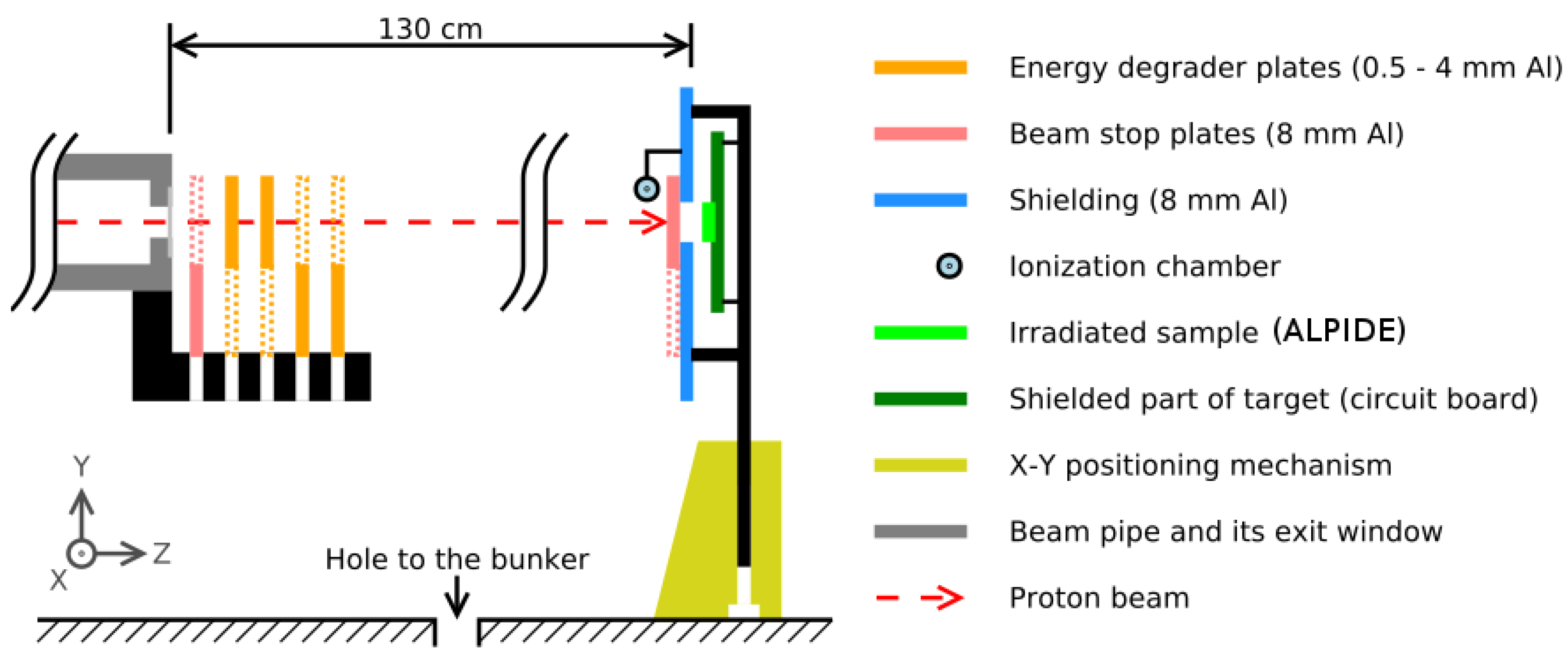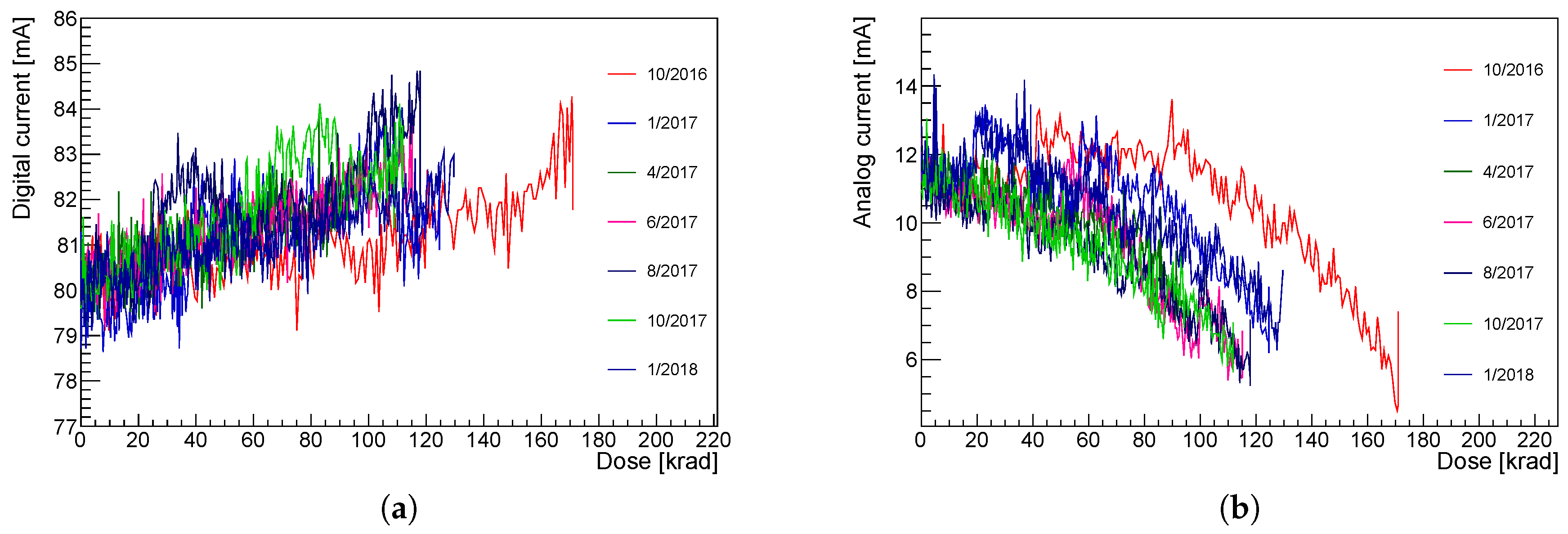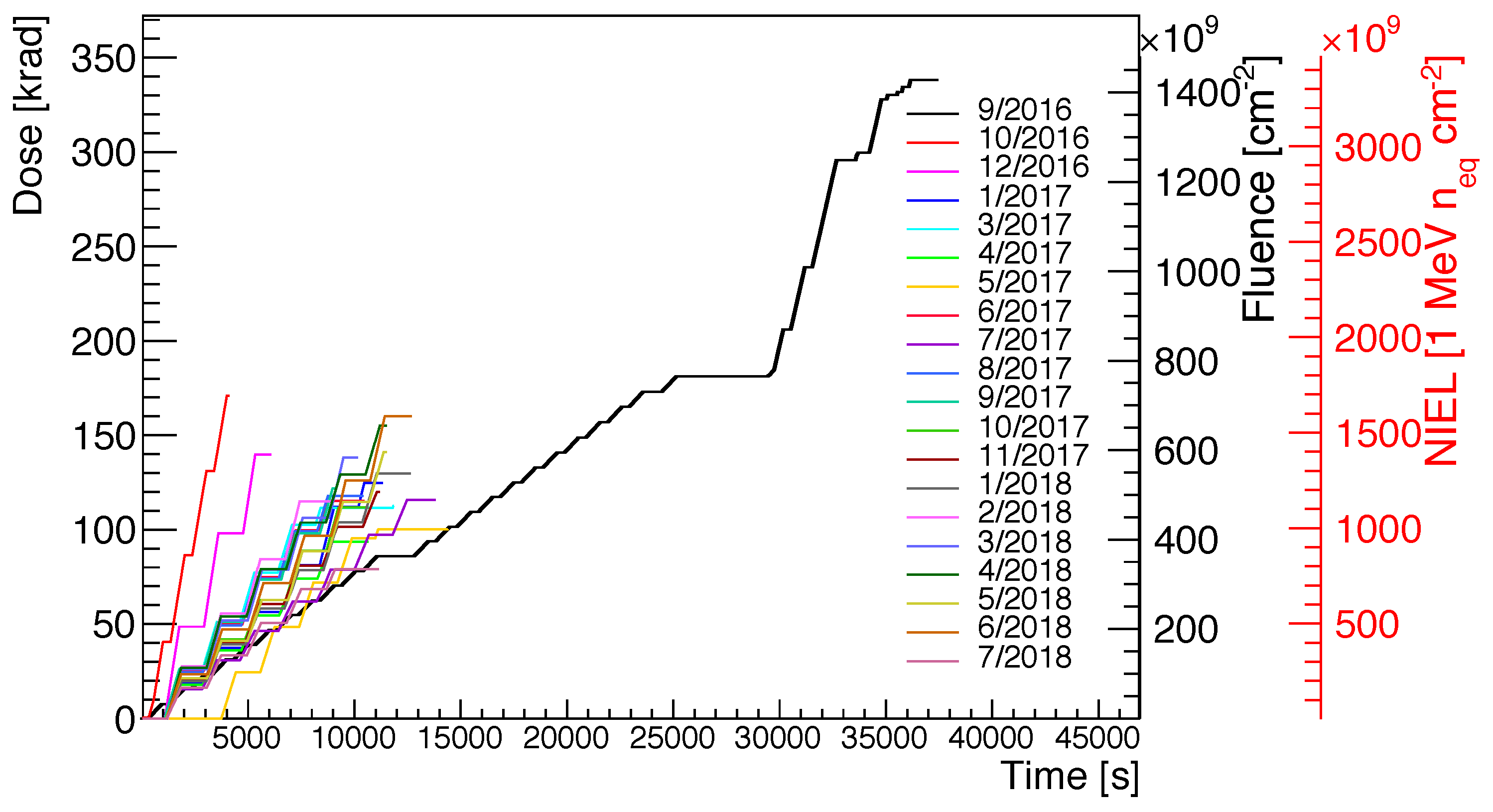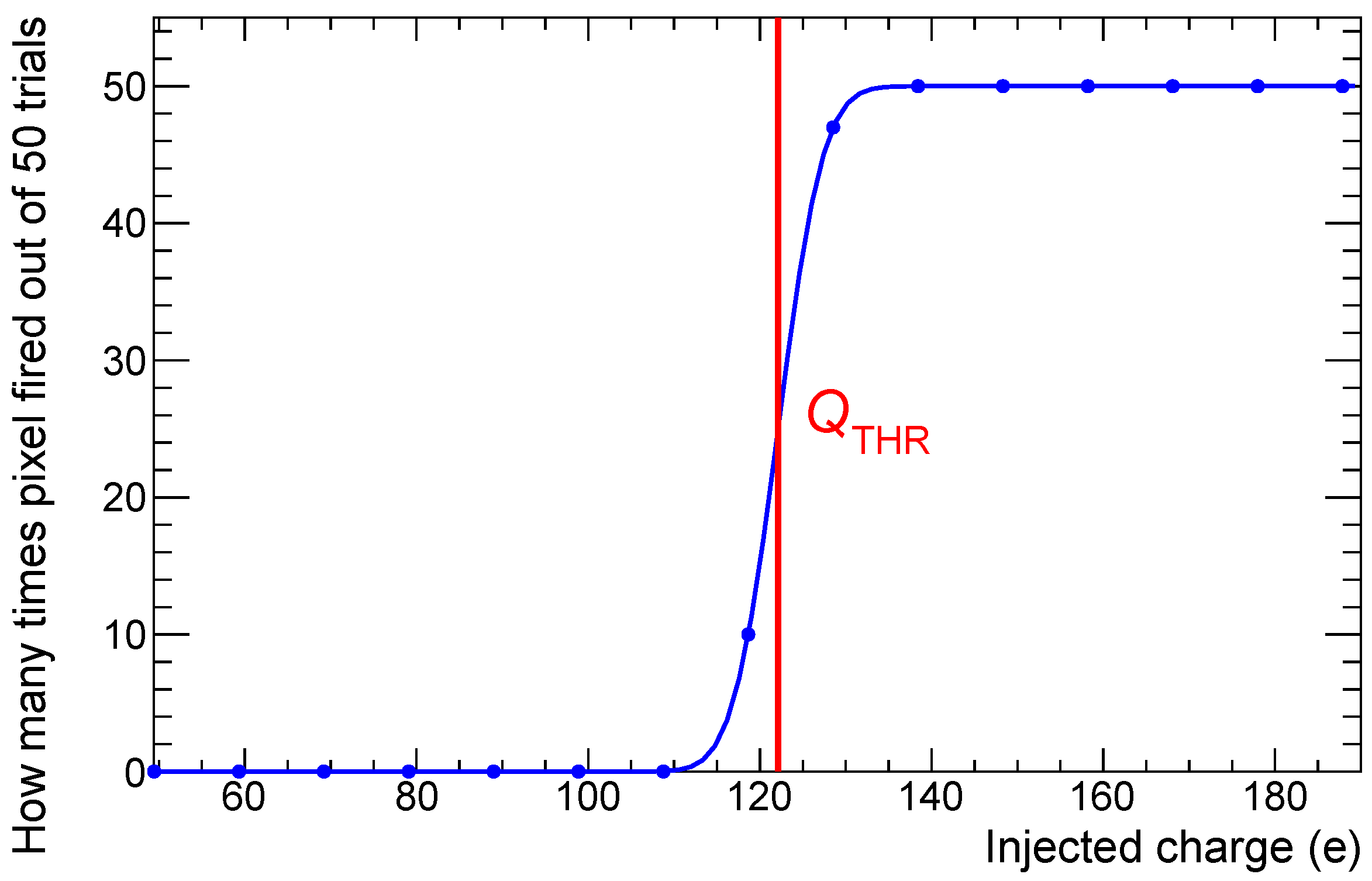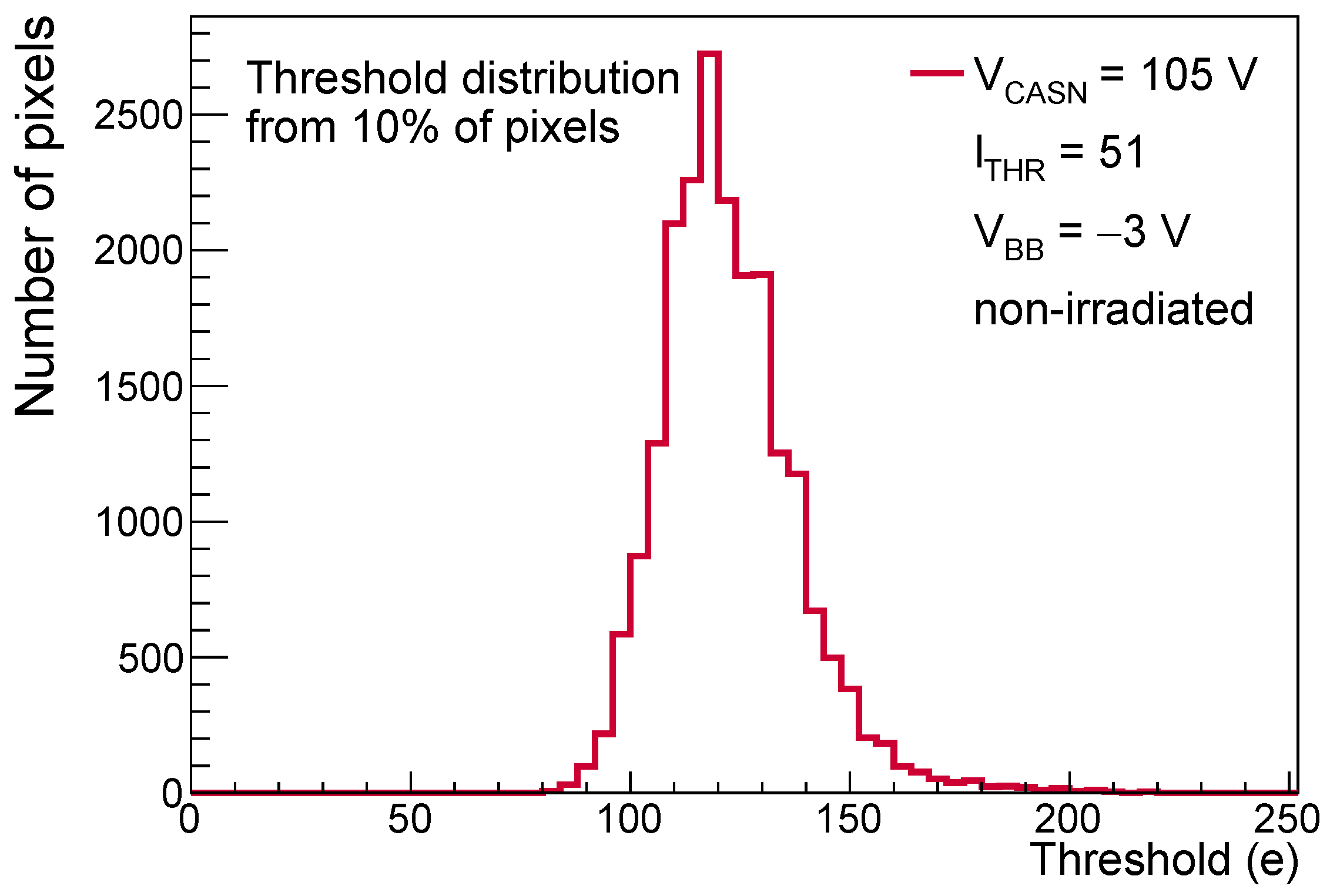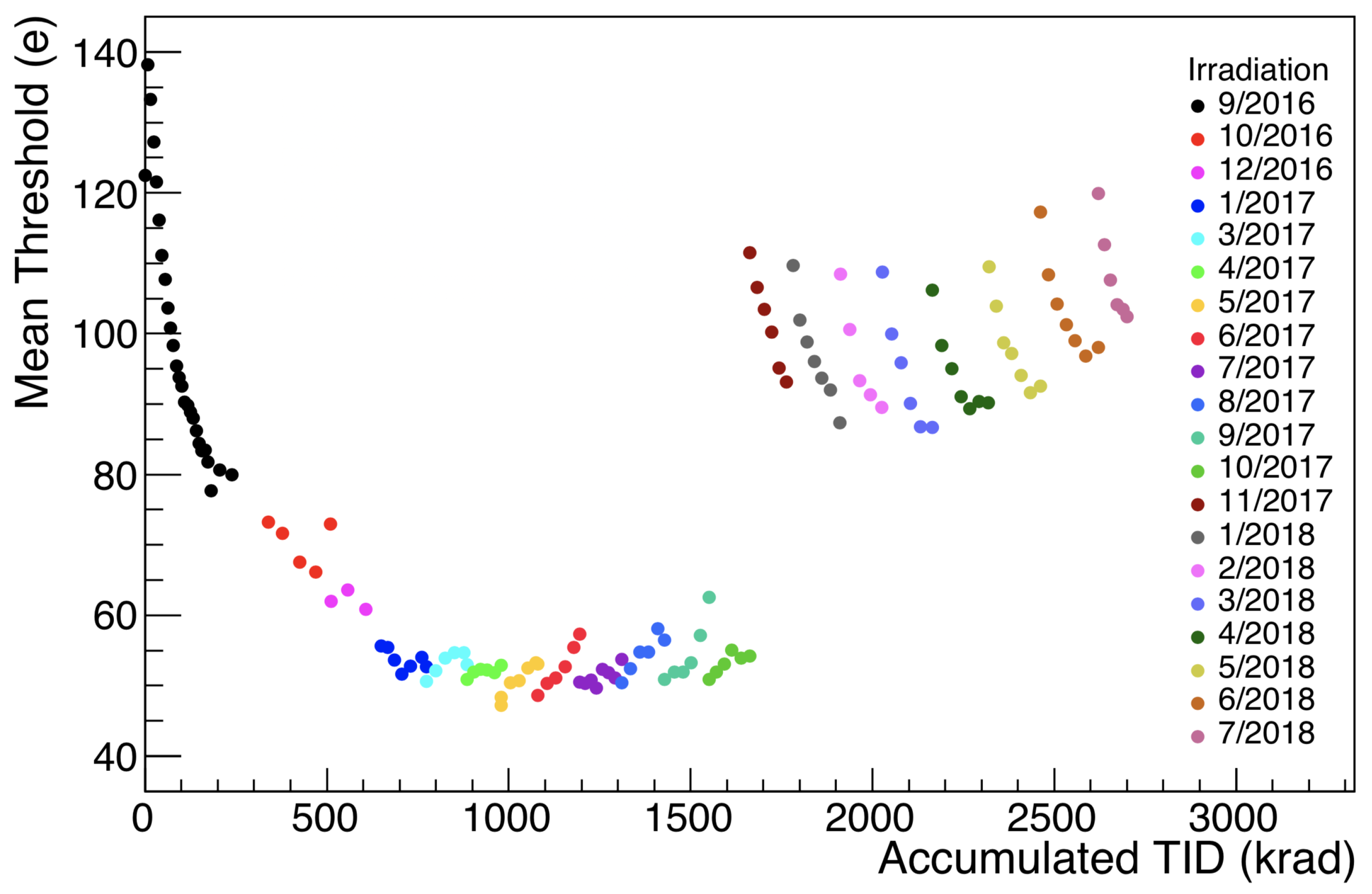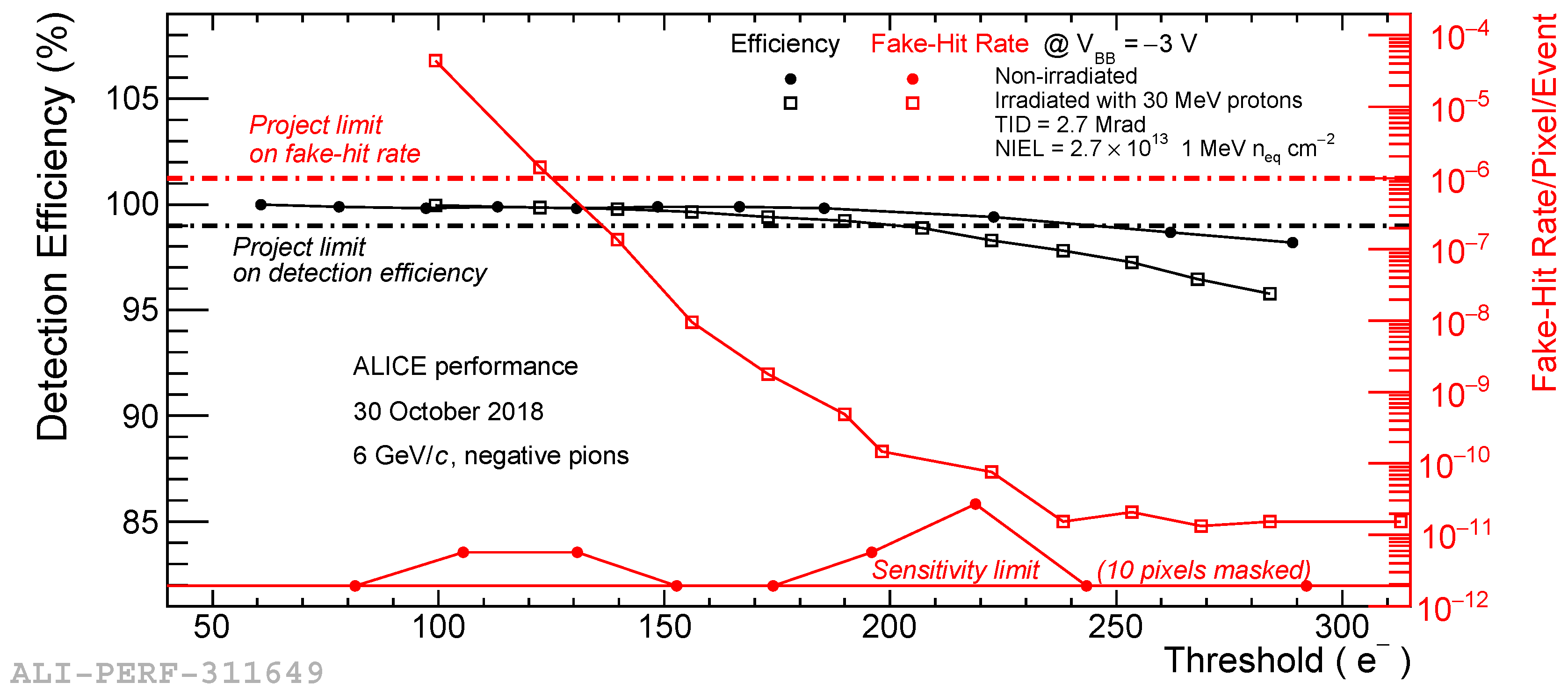1. Introduction
ALICE (A Large Ion Collider Experiment) [
1] is a high-energy physics detector at the CERN Large Hadron Collider (LHC). It is designed to study strongly interacting matter in the regime of high-energy densities and temperatures which occur when ultra-relativistic heavy nuclei collide. Under these conditions quarks and gluons escape their confinement in hadrons and form Quark–Gluon Plasma (QGP) [
2].
In 2019–2020, the LHC machine will be upgraded. This so-called second long shutdown will be followed by the Run 3 and Run 4 data-taking periods in which ALICE aims to perform detailed measurements of QGP properties using low transverse-momentum (
) open-heavy-flavor hadrons, quarkonia, light vector mesons, and low-mass di-leptons [
3]. Since these channels have a very small signal-background ratio, large statistics with un-triggered running is needed. ALICE plans to read minimum bias events in a continuous readout mode. Better vertexing and tracking efficiency at low
are needed, which requires significant upgrades of ALICE sub-detectors. Another motivation for the ALICE upgrade is the expected increase of delivered luminosity by a factor of 100 in Run 3 and Run 4.
2. Alice Inner Tracking System Upgrade
The ALICE upgrade program includes many sub-projects. This paper is related to the upgrade of the ALICE Inner Tracking System, ITS [
4]. This detector is essential for tracking and vertex reconstruction. The main goals of the ITS upgrade are: (i) to improve impact-parameter resolution of reconstructed tracks (by a factor of 5 in the longitudinal direction and by a factor of 3 in the transverse direction), (ii) to improve tracking efficiency and
resolution for charged tracks with
less than 1GeV/
c, (iii) to increase the readout rate, and (iv) to allow fast insertion and removal of the detector during the end of year technical stops. These goals will be achieved by shifting the first detector layer closer to the beam line from the current 39 mm to 23 mm, by reducing the pixel size, and by reducing the material budget
per layer from 1.14% to 0.3% for the three innermost layers and to about 1% for the outer layers. When compared to the current ITS [
1], which has 6 cylindrical layers of silicon detectors based on 3 different technologies (pixel, drift, and strip), the new ITS will have 7 layers of silicon pixel sensors called ALPIDEs, see
Figure 1. The three innermost layers form the Inner Barrel and the four outer layers form the Outer Barrel. The area covered by ALPIDEs will be about 10 m
. In total, there will be about 24,000 sensors [
5]. The upgraded ITS aims to read out data up to a rate of 100 kHz in Pb–Pb collisions and 1 MHz in pp collisions.
3. The Alpide Sensor
The basic unit of the new ITS is ALPIDE [
5,
6,
7], which stands for ALice PIxel DEtector. The sensor has a size of 1.5 × 3 cm. It is divided into 512 rows and 1024 columns of pixels with a pitch of 29.24 × 26.88
, which makes it possible to achieve a resolution better than 5
. The ALPIDE is a Monolithic Active Pixel Sensor (MAPS) which is based on the 180 nm CMOS technology of TowerJazz [
8]. This technology uses up to 6 metal layers which in combination with small structure size enables to implement high density CMOS digital circuitry with low power consumption. The average power density across the sensor surface is less than 40 mWcm
[
5,
7]. Another important feature is the implementation of a high-resistivity (>1 k
) epitaxial layer and a deep p-well, see
Figure 2. The deep p-well layer prevents the collection of charge carriers by the n-well of pmos transistors, therefore both nmos and pmos transistors can be implemented in the active pixel area. The thickness of the epitaxial layer is 25
. The depletion volume can be increased by applying a moderate reverse bias voltage to the substrate. This also lowers the capacitance of the collection diode and results in a higher collection efficiency [
7].
Each ALPIDE pixel contains a sensitive volume, as well as the front-end electronics. The electronics manage charge collection, signal amplification, and discrimination, and write binary hit information to an event buffer. There are several 8-bit DACs (Digital to Analog Converters) on the periphery of the chip, which regulate voltages and currents in the front-end circuits of pixels. The most relevant DACs for the work reported in this paper are voltage V
and current I
, which control charge threshold [
6].
Table 1 shows the required parameters of ALPIDE from the technical design report [
4] and the achieved performance. The table suggests that the performance of the sensor satisfies all requirements for the Inner and Outer Barrel. After Run 3 and Run 4, the expected total ionizing dose (TID) accumulated by a chip in the Inner Barrel will be 270 krad and the non-ionizing energy loss (NIEL) is expected to be 1.3 × 10
1MeV n
cm
. However, we tested the ALPIDE chip under up to 10 times larger radiation loads. The corresponding study is reported in this paper.
4. Radiation Hardness Tests at the Nuclear Physics Institute
Radiation hardness of ALPIDE sensors was tested using a 30 MeV proton beam provided by the U-120M cyclotron at the Nuclear Physics Institute of the Czech Academy of Sciences (NPI CAS) [
9]. For this purpose we use an experimental setup which is shown in
Figure 3. The extracted proton beam from the cyclotron has an energy of 34.8MeV with an RMS of 0.3 MeV and passes through a beam line which is terminated with an energy degrader unit. This unit contains 5 aluminum plates with different thickness which can be inserted into the beam using a remotely controlled pneumatic system. The first aluminum plate is 8 mm thick and serves as a beam stop. Thickness of the second plate is 0.56 mm. This plate is used during the ALPIDE irradiation to make the beam profile wider such that the ALPIDE sensor is irradiated more uniformly across its surface. The other 3 plates were not used in the experiment. The setup with the ALPIDE sensor is placed 130cm from the end of the beam line. The setup is mounted on a remotely controllable, movable stage and consists of an ionization chamber, another aluminum beam stop plate which can shield the irradiated ALPIDE sensor, and a passive aluminum shielding that protects a readout board connected with the ALPIDE sensor.
The ionization chamber Farmer 30010 from PTW-Freiburg [
10] is used to monitor the proton flux and is read out using a UNIDOS E Universal Dosemeter. The chamber has a sensitive volume of 0.6 cm
filled with air and provides a linear response to the incoming proton flux up to about
proton
cm
s
[
9]. The vertical distance between the center of the ionization chamber and the center of the ALPIDE sensor is measured using a laser tracker.
Based on GEANT4 simulation, it was estimated that the 0.56 mm thick energy degrader plate and the air decrease the beam energy from 35 MeV to 30 MeV before the beam hits the ALPIDE. The beam intensity profile is measured by moving the whole setup through the beam center along the horizontal and vertical direction. In both cases, the beam profile can be well described by a Gaussian with a standard deviation of about 22 mm. The dose absorbed in the irradiated sample is estimated based on the formula
where S is the linear energy transfer and
F is the proton fluence [
11]. The non-ionizing enegy loss induced by the 30 MeV proton beam is calculated as
where the factor 2.346 is a tabled coefficient taken from [
12].
Irradiation campaigns of each ALPIDE sensor took place every month since September 2016. ALPIDE was operated with
V reverse substrate bias. Sensors were irradiated with proton fluxes of the order of 10
proton
cm
s
. The ALPIDE irradiation was carried out as follows. The beam was interrupted periodically using the first beam stop plate. When the beam stop was out of the beam, the sensor was irradiated and analogue and digital currents consumed by the ALPIDE chip were monitored, see
Figure 4. When the beam stop interrupted the beam, threshold and DAC scans were performed. The dependence of the absorbed total ionization dose and proton fluence on time for different irradiation campaigns for one chip is shown in
Figure 5. The increasing trend in the curves corresponds to the irradiation and the flat trend corresponds to the period when the ALPIDE was not irradiated. The first irradiation campaign that took place in September 2016 was the longest one and the accumulated dose was the highest. In the rest of the campaigns, the chip got about 100 krad, which corresponds to about one third of the total absorbed dose expected during Run 3 and Run 4. After each irradiation campaign, the chip was left to anneal at room temperature.
In each pixel, charge threshold is measured by injection of a given charge from an injection capacitance to the pixel analog front end. The injection is repeated 50 times and the threshold is defined as a charge which is registered by a pixel with a 50% probability. In the case of ALPIDE sensors, the charge threshold depends mainly on two DACs: I
which determines the shape of the pulse and V
which regulates the baseline voltage [
6]. An example of the firing probability of a pixel versus the injected charge is shown in
Figure 6. The dependence is fitted by the so-called S-curve
where
Q is injected charge and
is threshold. The formula assumes that the temporal noise, which smears the threshold value, has a Gaussian character. The threshold distribution obtained from 10% of pixels for the default settings of the DACs for a non-irradiated chip is shown in
Figure 7.
Figure 8 shows the mean threshold as a function of the accumulated dose for different irradiation campaigns. Initially until October 2017, the ALPIDE was operated using the default DAC settings for
V reverse substrate back bias. In this period, the mean threshold was decreasing with the accumulated dose without any sign of annealing. In October 2017, the DAC settings of the chip were changed to increase the threshold and to suppress the noise. Since then we observe that the chip anneals after each campaign.
After obtaining the total ionizing dose of 2700 krad and the NIEL of 2.7 × 10
1 MeV n
cm
, the chip was characterized at the CERN Proton Synchrotron. There the ALPIDE was tested using a 6 GeV/
c pion beam. The sensor was installed in a telescope which consisted of 7 planes of ALPIDE sensors. The tested ALPIDE (device under test, DUT) formed the middle plane of the telescope, the other ALPIDEs served as reference planes for pion track reconstruction. The EUTelescope software [
13] was used to estimate the detection efficiency, which was obtained by comparing an extrapolated hit position in the DUT calculated from tracking planes with the actual measured hit position in the DUT.
Figure 9 shows the detection efficiency and the fake-hit rate as a function of the mean charge threshold for the irradiated chip and for a non-irradiated reference sensor. The red dash-dotted line corresponds to the project limit on fake-hit rate which is 10
/pixel/event and the black dash-dotted line gives the limit on detection efficiency which should be higher than
. As it is seen from the figure, the irradiated sensor still fulfills the requirements of the upgrade project in terms of detection efficiency and the fake-hit rate in the threshold range ≈ 150–200 electrons.
